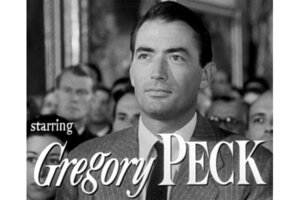Herman Melville book 'Moby-Dick' on screen stretches from Gregory Peck to 'Futurama'
The Herman Melville book 'Moby-Dick' has been parodied on TV and several directors have tried to capture the classic novel on film, though no movie version has quite attained classic status.

The Herman Melville book 'Moby-Dick' was adapted by director John Huston and writer Ray Bradbury for a 1956 film version starring 'Roman Holiday' actor Gregory Peck.
You doubtless know the classic beginning line, "Call me Ishmael," and the Herman Melville book details that follow: the main character, sailor Ishmael; the ship he travels on, the boat known as the Pequod; the mysterious Captain Ahab and his obsession with capturing a whale known as Moby Dick.
With much of the story taking place on the ocean, a massive whale serving as one of the main characters and a whirlpool featuring as part of the story's dramatic conclusion, "Moby-Dick" doesn't exactly scream "movie adaptation," but that hasn't stopped Hollywood directors from trying.
The story's first appearance in theaters came in 1926 with the silent movie "The Sea Beast," a story which bore similarities to Herman Melville's tale but was in fact a loose adaptation. In "Beast," Ahab, played by Shakespeare legend John Barrymore, falls in love with a girl named Esther who is later repulsed by his peg leg when Ahab's right leg is lost after he falls into the ocean with Moby-Dick. To those familiar with the novel, "Beast" would feature a surprise twist ending – unlike Melville's story, Ahab returns safe from his quest. Barrymore returned for a 1930 version of the story titled "Moby Dick," which remade the story with sound but follows the same plot as "Beast."
A 1956 version of the story appeared next, starring "To Kill a Mockingbird" actor Gregory Peck as the vengeful Ahab and directed by John Huston, who was also behind the movies "The Maltese Falcon and the African Queen." Huston collaborated on the screenplay with legendary sci-fi author Ray Bradbury and the relationship between the two during production was apparently not good. According to an interview Bradbury did with the Paris Review, Bradbury told Huston that he had "never been able to read the... thing" – meaning Melville's novel. And, Bradbury apparently felt that Huston bossed him around too much.
A massive prop whale was built for the production, clocking in at 85-feet long and weighing 12 tons. However, during production, it drifted away on the ocean, breaking free of its line, and was lost in the fog covering the sea at the time. The prop was substituted by attaching whale body parts such as a tail to a barge and filming miniatures of a whale as well as using a life-size version of the whale's head, complete with moving eyes, for close-ups, according to a Turner Classic Movies feature.
The relationship between Huston and his lead actor, Peck, was also reportedly less than cordial after Peck found out he wasn't Huston's first choice for the part of Ahab, and the two stopped speaking in later years. The production went over budget and, though it was a fairly faithful adaptation of Melville's novel and kept the original ending, the movie was considered a financial disappointment at the box office. Still, some reviews were positive, with the New York Times calling the film "one of the great motion pictures of our time."
A 1965 film moved Captain Ahab to the present day and retitled the story "The Bedford Incident," swapping in an American destroyer called the USS Bedford for the famous Pequod. In 1998, "Star Trek" actor Patrick Stewart appeared as Ahab in a made-for-TV movie which also featured Gregory Peck playing Father Mapple. In 2010, "The Rocky Horror Picture Show" actor Barry Bostwick took on the role of Ahab for an adaptation titled "Moby Dick" which also updated the story – this time, to 1965 – and was released on video. The movie was criticized for giving the whale Moby-Dick unlikely powers, including the ability to crawl on land, and citing the whale as 500 feet, an unrealistic size.
Haven't read the book, but you're familiar with the details of the story anyway? Cartoon fans may have absorbed the story unconsciously by now, with every animated series from "Tom and Jerry" to "The Simpsons" referencing Melville's novel.
In the 1957 short "Woody Woodpecker: Dopey Dick the Pink Whale," Woody is brought onto a boat by a character, Dapper Denver Dooley, to help Dooley pursue a whale that bit him.
"Tom and Jerry: Dicky Moe," the 1962 cartoon, follows Tom as a hapless sailor who serves under the command of an unnamed captain with a peg leg who's obsessed with hunting a whale named Dicky Moe.
In "The Flintstones," a 1964 episode featured Fred sighting a creature he calls a "whaleasaurus." In 1967, the famous whale got his own show with the Hanna-Barbera series "Moby Dick and Mighty Mightor" as well as a personality makeover – in that version, the creature sometimes viewed as villainous rescues two young boys who ran into danger on the ocean.
Meanwhile, a little more recently, the Comedy Central series "Futurama" aired an episode in 2011 titled "Möbius Dick" in which the spaceship crew encounters a space whale that eats their engine, causing heroine Leela to swear revenge on the creature.

